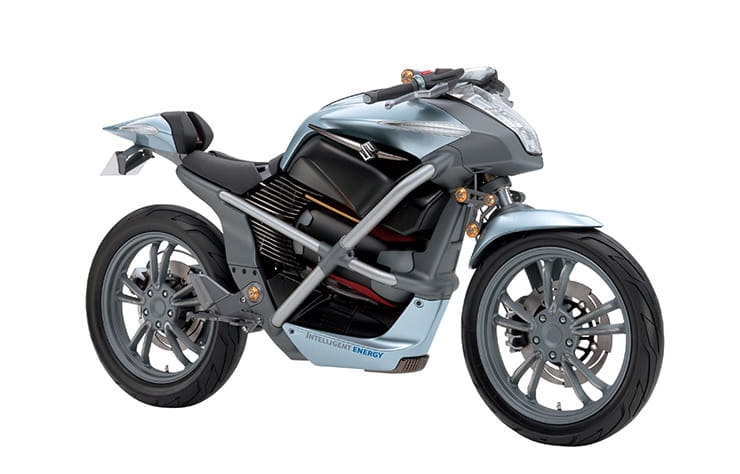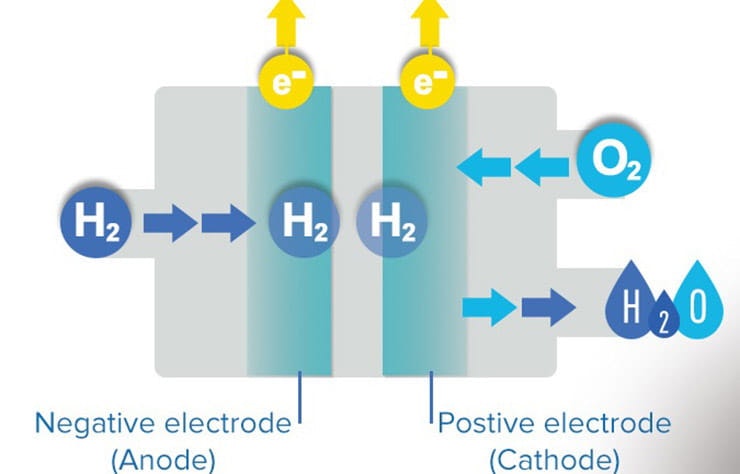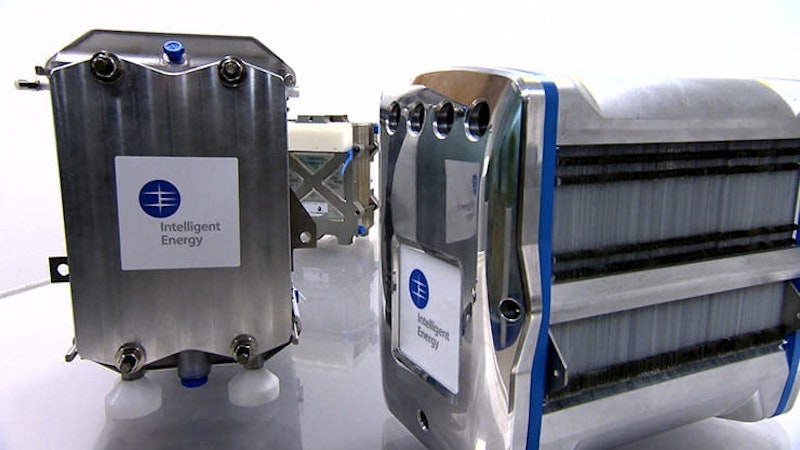Hydrogen fuel cells: is it the future for motorbikes?
By Ben Purvis
Motorcycle Journalist
21.11.2017
Range Anxiety: the overarching problem with electric bikes
Like it or not it’s likely that electric bikes are going to become a growing part of the motorcycle landscape in years to come. In just the last few weeks we’ve seen new electric scooters from mainstream players like Honda and Vespa. Yamaha is also in on the action, particularly in Japan, as is Peugeot, and recent shows have never been complete without a battery-powered concept bike or two.
And that’s not to mention the endless stream of new start-ups appearing on the scene with electric bike projects.
But the biggest single stumbling block to electric power still hasn’t been addressed; range anxiety.
That’s quite simply the worry that, once your electric bike’s battery is flat, that’s it. You’re stuck. At least until it can recharge, and that might take several hours.
Even when we can logically look at our bike usage and know precisely how many miles we travel per day, and even if that number falls well below the range of an electric bike, the niggling fear remains. What if you need to make an unexpected trip? What about that big tour that you keep saying you’ll get around to?
With a petrol bike it’s easy. Pull in to one of a million filling stations, spend a couple of minutes topping off your tank and you’re set for another couple of hundred miles. With batteries? No so simple.
How could hydrogen help?
And that’s where the idea of hydrogen-powered bikes comes in. In theory they provide emissions-free transport without the cripplingly-slow recharging times.
There are two ways to use hydrogen as a fuel, and both result in exhaust that’s simply water. H2O.
The simplest is to use a fairly normal internal combustion engine. Several firms have successfully converted petrol engines to work using hydrogen. Weight-for-weight, hydrogen is far more power-dense than petrol, too. You get 142 megajoules from 1kg of hydrogen, equivalent to 53 horsepower for one hour (53hp*h), compared to 46 megajoules (17hp*h) from 1kg of petrol.
However, a petrol engine is only about 25% efficient when running on hydrogen (and little better on petrol) so the majority of that power is simply wasted as heat and noise. It’s far more sensible to use a hydrogen fuel cell, which converts the chemical energy stored in the hydrogen directly into electricity. That can give 60% efficiency or so once powering an electric motor.
That means you’ll get around 85MJ of useable power – 31.6hp*h – from a kilo of hydrogen running through a fuel cell. A normal internal combustion engine, working at perhaps 30% efficiency, will give a little over 5hp*h from a litre of petrol.
Sounds brilliant, doesn’t it? But you’ll notice we’re talking about kilogrammes of hydrogen. A gas that’s lighter than air. And there, at least in part, lies the rub.
Problems with hydrogen
1: Fitting it in your tank
While hydrogen has great energy density in terms of weight, it’s terrible in terms of volume. Sure, you can try to cool it down to the point where it becomes a liquid, but that’s -250°C or so. The energy needed to achieve the cooling is vast, and the insulation to keep it cool is bulky.
It might sound crazy, but there’s also more hydrogen in a litre of petrol than there is in a litre of pure liquid hydrogen.
Even in liquid form hydrogen is incredibly light – at around 71g per litre it’s less than a tenth of the weight of the same amount of petrol, in which the hydrogen is stored as a hydrocarbon compound. So while more energy-dense in terms of power-per-kg, hydrogen is far worse than petrol when it comes to power-per-litre.
Liquid hydrogen poses such problems that while it’s useful as rocket fuel, it’s not really viable for day-to-day transport. In the real world, hydrogen is more likely to be stored as a compressed gas than in its liquid form. The few vehicles in use today that are powered by hydrogen tend to keep it at around 700 bar (10,152psi), and that means they need immensely strong, and heavy, fuel tanks.
Even then the hydrogen is so light that it’s hard to store more than a small amount. Perhaps the most advanced hydrogen fuel cell car on the road at the moment, the Honda Clarity, can only carry 5kg of hydrogen in a 117-litre tank. Even with the efficiency of a fuel cell, that means its range is only on a par with a conventional car – around 300 miles between fill-ups.
2: Getting it to your tank
Even if you’ve got a high-pressure tank to keep your hydrogen in, there’s a significant problem in storing it and moving it around. While it’s simple for petrol to be trucked about in big tankers, hydrogen really needs pipelines to move it about in large quantities. Filling stations would also need to be comprehensively re-equipped to deal with the gas rather than the liquid fuels they’re designed for. And of course you can’t just pour it in – there needs to be a sealed refilling system capable of dealing with the massive – 10,000psi-plus – pressure. There are potential solutions to the storage and transport problems, notably the idea of storing the hydrogen as a chemical hydride or absorbing it into another material. Cella Energy, for instance, has been working on spherical chemical hydride pellets that can flow almost like a liquid but release large amounts of hydrogen when heated to 100 °C. But at the moment industrial-scale production seems a way off.
3: Getting it in the first place
Even before you get to the problems of moving, storing or using the hydrogen, you’ve got to actually get hold of it. There are various ways of doing that, but the most common ways are getting it from fossil fuel – which isn’t renewable, of course – or using electrolysis to get it from water. The problem with the latter is that it needs a lot of electricity that has to be generated somehow, and the process itself has losses.
At best it’s around 80% efficient. So you’d use 100 megajoules of electricity to get hydrogen containing 80 megajoules of power. Run that hydrogen through a fuel cell at around 60% efficiency and your initial 100MJ is slashed to just 48MJ of useable power.
These are the reasons why, at the moment, the vast majority of electric vehicles use batteries rather than hydrogen. Elon Musk, owner of electric car pioneer Tesla, who’s spearheaded the biggest advances in electric vehicles in recent years, said this of hydrogen fuel cells: “I just think that they’re extremely silly…” before going on to explain some of their shortcomings.
In another interview, he gave a slightly more moderate view, saying: “My personal opinion is that hydrogen is not the way to go. Not just because I run an electric car company; I mean I could have started a hydrogen car company. My opinion pre-dates Tesla.”
Suzuki Burgman hydrogen powered vehicle
At the moment, the difficulties of hydrogen production, storage and delivery mean fuel cells a distant second in the electric vehicle development race. Batteries, despite their slow recharging and the range anxiety it causes, are well in front.
But that hasn’t stopped some companies from pursuing the fuel cell idea. Honda, notable, has a hydrogen fuel cell car – the Clarity – in production (albeit in small numbers). It’s also shown several fuel cell bikes over the years, notably the FC Stack concept way back in 2004. And as recently as October this year Honda published a new patent application for another new hydrogen fuel cell motorcycle.
Toyota also makes a hydrogen fuel cell car, the Mirai, which can be bought in the UK. Nobody does, though, in part because it costs £66,000 and only a handful are brought over each year but mainly because there are fewer than a dozen filling stations in the whole country.
Other firms including Volkswagen, Hyundai and General Motors are also working on fuel cell vehicles.
The Honda Clarity hydrogen powered vehicle
On two wheels, the most active proponent of the hydrogen fuel cell is Suzuki. Its Burgman fuel cell scooter came on the heels of the Crosscage concept bike back in 2007, and has been developed with the help of UK-based specialists Intelligent Energy. The fuel cell Burgman was type-approved for mass production back in 2011, and has most recently been trialled by the Met Police in London, but has yet to actually be developed into a real production machine. Suzuki has also patented designs for a hydrogen fuel cell motocrosser and a fuel cell sports bike fairly recently.
Regardless of their maker, the fuel cells work in much the same way. Like a battery, the fuel cell has an anode and a cathode. These are separated by an electrolyte. The hydrogen flows into the anode while oxygen or air goes into the cathode.
In the anode the hydrogen is spilt, via a platinum catalyst, into positive hydrogen ions and negatively-charged electrons. Only the ions can pass through the electrolyte to the cathode, giving it a positive charge. The electrons go to the cathode via an external circuit, providing electric current. The hydrogen ions, electrons and the oxygen combine in the cathode to become water.
Toyota's hydrogen powered truck concept
Does hydrogen power have a future?
With the likes of Honda, Toyota and Suzuki putting efforts into fuel cell cars and bikes, there are clearly some very clever people out there who strongly believe that they are here to stay. However, in the short to medium term at least, batteries appear to have an advantage.
Not only do they have a head-start in terms of development and refuelling/recharging infrastructure, but the energy losses involved in splitting hydrogen from water, transport and storing it all bite deeply into its efficiency margins. Meanwhile, more energy-dense batteries are constantly being developed, nibbling further into hydrogen’s remaining advantage.
However, the fact that hydrogen allows for fast refuelling of electric vehicles remains a massive point in its favour, and one that batteries – even with advances in charging technology – struggle to counter.
In future, that may give hydrogen fuel cell an edge, particularly in vehicles that can’t afford recharging down-time. In that respect, the onrush of autonomous vehicle technology could play into hydrogen’s hands – driverless taxis and commercial vehicles could be expected to operate 24/7, making the prospect of lost business hours recharging them a big negative for their owners. Toyota recently revealed a prototype fuel cell powered lorry that’s completed more than 4000 miles of testing in America, and intends to provide fuel cell delivery trucks to Seven-Eleven in Japan. These may well be the types of vehicles that initially make the most of hydrogen power.
Honda's hydrogen powered PCX scooter
A better idea? Hot-swappable batteries
On two wheels though, batteries are still the firm favourite, and some companies – Honda, Yamaha and Kawasaki included – have plans to eliminate the whole issue of recharging by simply making their batteries swappable.
Yamaha and Honda have both recently got involved in a test initiative (E-KIZUNA) in Saitama City, Japan, where they’re trialling production electric scooters with swappable batteries. The idea is to build both a charging infrastructure and a ‘safety net’ whereby local businesses would keep replacement batteries on standby, fully charged, for when they’re needed.
Yamaha's E-Vino hydrogen powered scooter
Both Yamaha’s e-Vino scooter – launched in 2014 – and Honda’s newly-revealed PCX Electric have batteries that simply slide out and can be replaced in seconds. Yamaha’s forthcoming PES and PED electric bikes – shown in prototype form in 2013 and 2015 and promised for production soon – also use the same idea. Kawasaki, while not so open about its plans, has also filed patents showing electric bikes with swappable battery packs.
While swapping batteries isn’t a technology that’s well suited to cars – they need such huge batteries that it makes sense to build them in to the chassis – it’s the perfect technology for bikes and if widely adopted, with standardised batteries shared across manufacturers, could eliminate range-anxiety for good.
Conclusion: why not both?
In the final reckoning there’s actually no reason to believe either battery or hydrogen fuel cell power will become a dominant, overarching technology. People will buy the bikes that work best for their needs, and for year to come the choices are likely to grow – petrol, battery-electric, fuel cell electric, hybrid and who knows what else – rather than shrink. On four wheels, petrol and diesel have survived side-by-side for decades. In bikes the V-twin didn’t eradicate the single, the inline four hasn’t killed the triple. On the contrary, consumers demand ever more options.
The other constant is that products constantly improve. Regardless whether they’re powered by batteries, hydrogen, petrol or something we haven’t even thought of yet, tomorrow’s bikes will be better than today’s. And given how good the ones we have now are, that’s going to be an astounding achievement.
Share on social media:



